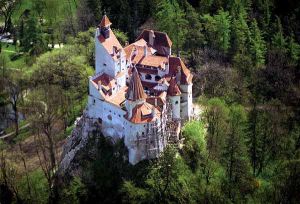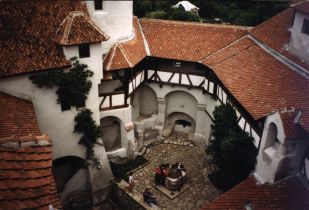 Bran, in German called Törzburg, in Hungarian Törcsvár, in old Romanian called Turciu, is a small town in Brasov county, in Romania, Europe. The name Bran is derived from Turkish, and in the Turkish language, it means “gate”, or “gateway”.
Bran, in German called Törzburg, in Hungarian Törcsvár, in old Romanian called Turciu, is a small town in Brasov county, in Romania, Europe. The name Bran is derived from Turkish, and in the Turkish language, it means “gate”, or “gateway”.
The construction of the castle was first started at the beginning of the 13th century, by the Teutonic Knights. In its first form, the castle was constructed solely of wood and was completely destroyed by the Mongol hordes in 1242. In 1377, the Hungarian king Sigismund started the building of a castle made of stone, during which period the first development of the town began.
The castle was built on a very abrupt hill and was meant to protect a strategic passing point between the then separate two countries, Valahia and Transilvania. In 1498, the castle and town came under the jurisdiction of the larger town nearby, Brasov.
Today, the once strategically important castle is a mere shadow of its former glory and is home to the Bran museum, all four of its floors being overtaken by the museum’s expositions. Clay pottery, long forgotten medieval military armoury, and medieval furniture are among some of the museum’s expos.
In the courtyard, where nobility used to come and go, a small village museum has been set up, in order to present to the museum’s visitors the village life of the medieval era in as much detail as possible.
Visiting hours are from 10 am to 6 pm, and prices are really cheap and totally free for kids.
But the medieval history that is being preserved in this castle is not the only thing that is making this castle famous, this is also the castle of the legendary vampire king, Dracula, the Romanian ruler Vlad Tepes, about whom countless legends and tales have been written, and whose legends contributed in great detail even to the creation of modern-day vampire movies, such as Twilight or True Blood, to name just the two that come to mind at first glance.
Was the real person, the ruler Vlad Tepes really a vampire? Nobody knows for sure. There are some real, historical accounts, however, that speak of an extraordinarily harsh, unforgiving ruler in his person who tortured his enemies and subjects alike by hanging them on wooden sticks, stroke through their bodies from bottom to top.
However, he only became famous as Dracula, as a blood-drinking undead, after the appearance of the Irish author Bram Stoker’s 1897 novel with the same title. He was a fierce ruler, who is convinced that the country’s defenses needed discipline not only in the military but also among the common people, he inforced and enacted laws that made honesty, diligence, and hard work rewarded, while theft, laziness, lack of diligence was severely punished by physically sticking on a wooden stick, and left for dead on that (Impaled, hence his more historically accurate name, “Vlad the Impaler”).
One of the most renown historians that wrote about this ruler presents him as someone who was totally unacquainted with mercy or forgiveness, however, this ruler was also the most prominent one that brought the country back from its decadent lifestyle and outcast status to a recognised and important status. History can teach you more about the historical Dracula that lived during the Medieval era of the middle ages.
The real “Dracula”, the ruler Vlad Tepes, was captured in battle with the Hungarian king Corvin Matyas, just 25 miles from his castle, and after the castle’s defeat by the same king, Vlad was imprisoned in his own castle for two months, and then taken to Visegrad.
Present day Bran castle is a flourishing community, a constant tourist attraction and a place most western tourists want to visit.
————————————————————————————————————————————-
Editor’s Note: Tezuka is a fellow traveller from Romania who has joined us as a Guest Author.Catch Tezuka on his blog HERE for the beautiful pictures from all over Romania.


wow dracula
wonderful post
Loved the second picture!
After reading The Historian I remember going through the life and deeds (gruesome they were…he was named the impaler after all) of Vlad Tepes crazily. I would actually love to go there (wallachia and transylvania) to actually see it all.
Aah ! Transylvania ! Have you read “Dracula”, in that the author will mention this place in such a mystical manner. Transylvania has got a permanent place in my wild imaginations since then, further fueled by films like Bram Stoker’s Dracula and Van Helsing.
About Vlad, it is said that the invading Turkish Army was horrified and they returned back after seeing the gruesome sight of 12000 of their soldiers captured by Vlad earlier impaled on stakes on both sides of the road. Such was his cruelty.
Transylvania is one of the most magical places in the world, literally, if we think about it for a while, actually count Dracula/Vlad Tepes was only one of many rulers like him, we had countesses who bathed in young girls’s blood, and other junkhead rulers. The place itself however, the Carpathians, the forests, the many mystical lakes, forged in legend and linking eternity to our daily lives… is simply magnificent.
Many of the NAMES of the places, towns, villages, are as old as ATLANTIS itself, and some of the words spoken by the native inhabitants, the “seclers”, even had meanings in the time of ancient Sumeria.
Ancient legends speak of the fact that the Huns, the forefathers of the seclers, were actual descendents of the star-people, the Anunnaki, and are direct descendents of Nimrod. Our linguistical heritage is so huge, that many of the current-day archeologists have to learn Hungarian and some secler dialect, if they are to understand some of the ancient sites, at all 🙂